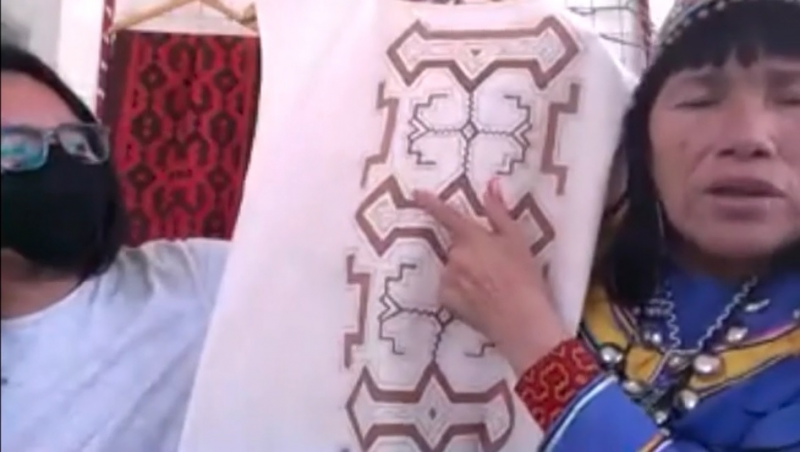This project is based on a collaboration between the artist and activist Olinda Silvano and the Non Shinanbo (“Our Inspirations”) group of artisan mothers of the Shipibo community in Cantagallo in Lima, Peru. Located along the Rímac River, this community is comprised of a large Shipibo-Konibo migrant community that has been fighting for its right to live in the city as Indigenous people. Through her work as a promoter and activist leader, Olinda has encouraged many women artists and artisans to transmit the Shipibo heritage through paintings, weavings, drawings, and songs.
In April 2021, conversations began between Olinda and the Non Shinanbo collective to invite them to elaborate a series of works sharing their experience during the health, social, and political crisis that Peru and the world were going through. The community of Cantagallo was severely affected at the beginning of the pandemic, when little was known about the virus. In a context in which many Indigenous populations were left – and still are today – without adequate intercultural medical care, it was the mutual care, community accompaniment, and the use of medicinal plants – matico, ginger, mucura, wild garlic, among others – that allowed them to make it through the emergency situation.
Through dialogue with Olinda, 29 members of Non Shinanbo who currently reside in Lima and Pucallpa were invited. Each of the women has been developing different pieces that make up textile and pictorial testimonies of the current moment. The work of producing the pieces started in September 2021 and has continued to today (January 2022). It includes the production of nearly one hundred works of different sizes and materials, including paintings on bark and canvas, embroidery, textiles, and objects. These works address the community’s experience, the wisdom transmitted by plants, the powers of Ronin (the primordial serpent), maternity, collective work, the memories of communities in the Amazon, the owners (guardian elements of nature), migration, the impact of COVID-19 in urban and Indigenous areas, their way of inhabiting public space, oral memory, and reciprocity, among other aspects that document the current struggles of the Shipibo-Konibo people and how they have developed an important political voice and agency.
This collaboration sought to contribute to improving the infrastructure and working conditions of Non Shinanbo and their community, to strengthen their processes of internal social organization, and to construct new bridges for conversation between the women creators and the public sphere. In practical terms, this has meant generating a dynamic of mutual listening and co-responsibility in decision-making processes and the use of the general production budget. Thus, the budget has not only served for paying honorarium to all the participants, but also for acquiring work materials (tables, chairs, awnings, brushes, canvasses, paint, wool, among others), technology and equipment (overlockers, video and photography equipment, among others), generating educational dynamics (workshops about how to use the machines and textile improvement), and buying goods for the collective benefit of the community (water tanks, accessories, among others).
In turn, a series of lines and concepts emerged that have served to connect different components of the project as a whole, including the INSITE Journal, dedicated to the project, Viewpoints, and the public conversations. These range from notions such as collectivity, weaving and healing, present in their practice in different ways, to aspects associated with migration, tensions with the nation-state model, or the ways in which the geometric forms of kenè reveal multiple horizons of affective and social meaning. This set of images and processes allows us to approach the recent global crisis from situated places that clearly show that the pandemic is not only a health emergency, but a crisis of environmental justice and the planet’s sustainability.
Miguel A. López


